The Lunar New Year celebration marks the arrival of spring and is the most important holiday in Vietnamese culture. Food plays a central role in Vietnamese New Year traditions, both symbolically and as the fuel that sustains families throughout days of elaborate rituals, ceremonies, and festivities. This article explores the culinary customs that make Tết Nguyên Đán (Vietnamese New Year) such a delicious time of year.
Vietnamese New Year food traditions reflect themes of luck, health, prosperity, and the cyclic nature of life. Certain dishes are eaten specifically for their auspicious symbolic meanings or propitious phonetic sounds. For example, pickled onions and scallions represent longevity and continuity, while fatty pork signifies progress and riches. Round and square sticky rice cakes embody the four pillars of life – phồn vinh, an khang, thọ vượng, phát tài (prosperity, peace, longevity, and wealth).
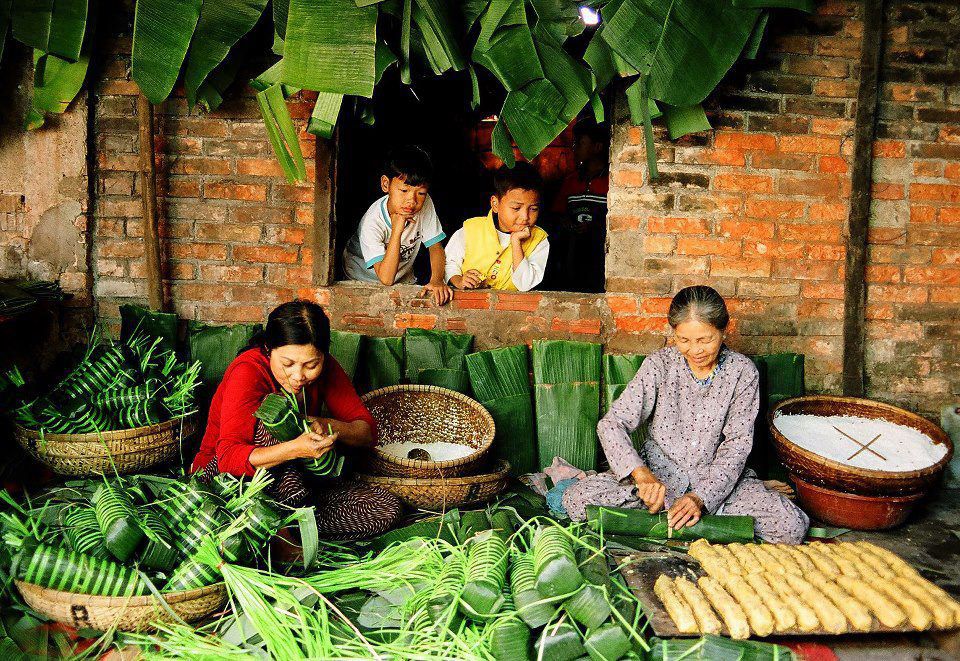
At the heart of any Tết feast is bánh chưng, soft rice cakes stuffed with pork and beans and boiled in banana leaves. These hearty green cubes wrapped in nature’s packaging pay homage to Vietnam’s agrarian roots. Making bánh chưng is a labor-intensive, communal ritual that reaffirms bonds and shared history. Another iconic Vietnamese New Year dish is giò chả, or Vietnamese sausage, which gets its reddish-brown hue from anise seed. Sliced thin and fried to a crackling crisp, giò chả makes for a very satisfying appetizer.
No Tết table would be complete without a whole steamed fish, typically carpe or catfish, served with a vivid garnish of fresh herbs and chili peppers. The fish represents surplus and wealth, its undulate form mirroring the flow of abundant blessings and fortunes. A whole chicken or fatty duck also promise prosperity in the coming year. Other celebratory centerpiece dishes include braised pork belly, a stewed oxtail soup called dồi sụn, and decadent crab and shrimp cakes.
On New Year’s Eve, Vietnamese families gather around an altar to pay respects to their ancestors before sitting down to a reunion dinner, or giao thừa, at midnight. This lavish meal ushers in the new year and is believed to set the tone for the next 365 days. After the feast, families continue celebrations by releasing floating candles on nearby lakes or rivers and then staying up all night to wait for the first sunrise. The weeklong holiday is filled with visiting friends and relatives, giving out li xi (red envelopes stuffed with lucky money), watching lion dances in the street, and more eating.
Some classic Vietnamese New Year desserts and snacks include chè trôi nước, a sweet dumpling soup; bánh tét, cylindrical rice cakes filled with mung beans; candied kumquats; dưa hành, pickled onions; and mứt, an assortment of dried fruits and seeds. Green bananas and coconut are especially popular as they herald the fresh fruits of spring. Vendors sell festive sticky rice and bean treats from temporary stands and mobile carts everywhere.
After seven days of parties and excess, the final day of Tết is bittersweet. Families gather one last time to trade hugs and well wishes before the holiday officially ends. They gently usher out the old year by releasing candlelit mini boats made of flowers and banana leaves on rivers and ponds in a wistful ritual called hát trống quân. Then it’s finally time to say goodbye to the holidays and to welcome the promises of a new lunar year.
Key Traditions and Symbolism of Vietnamese New Year Food
- Bánh chưng – iconic square glutinous rice cake
- Giò chả – Vietnamese sausage
- Whole fish – signifies surplus and prosperity
- Bánh tét – cylindrical sticky rice cakes
- Canh măng – bok choy and black mushroom soup
- Pickled onions and radish – represent longevity
- Chè trôi nước – sweet dumpling soup
- Candied fruits – kumquats, coconut
- Gấc – bright orange fruit signifies luck
- Green bananas – arrival of spring fruits
Foods like bánh chưng and giò lụa are prepared in large batches through a communal effort to nurture community bonds. Vibrant reddish-brown dishes reference mythical kitchen god Ông Táo. Greenery from herbs and banana leaves signal the freshness of spring. Combined, the traditional dishes offer wishes for health, wealth, happiness, and prosperity in the coming year.
Elaborating on Key Vietnamese New Year Food Traditions
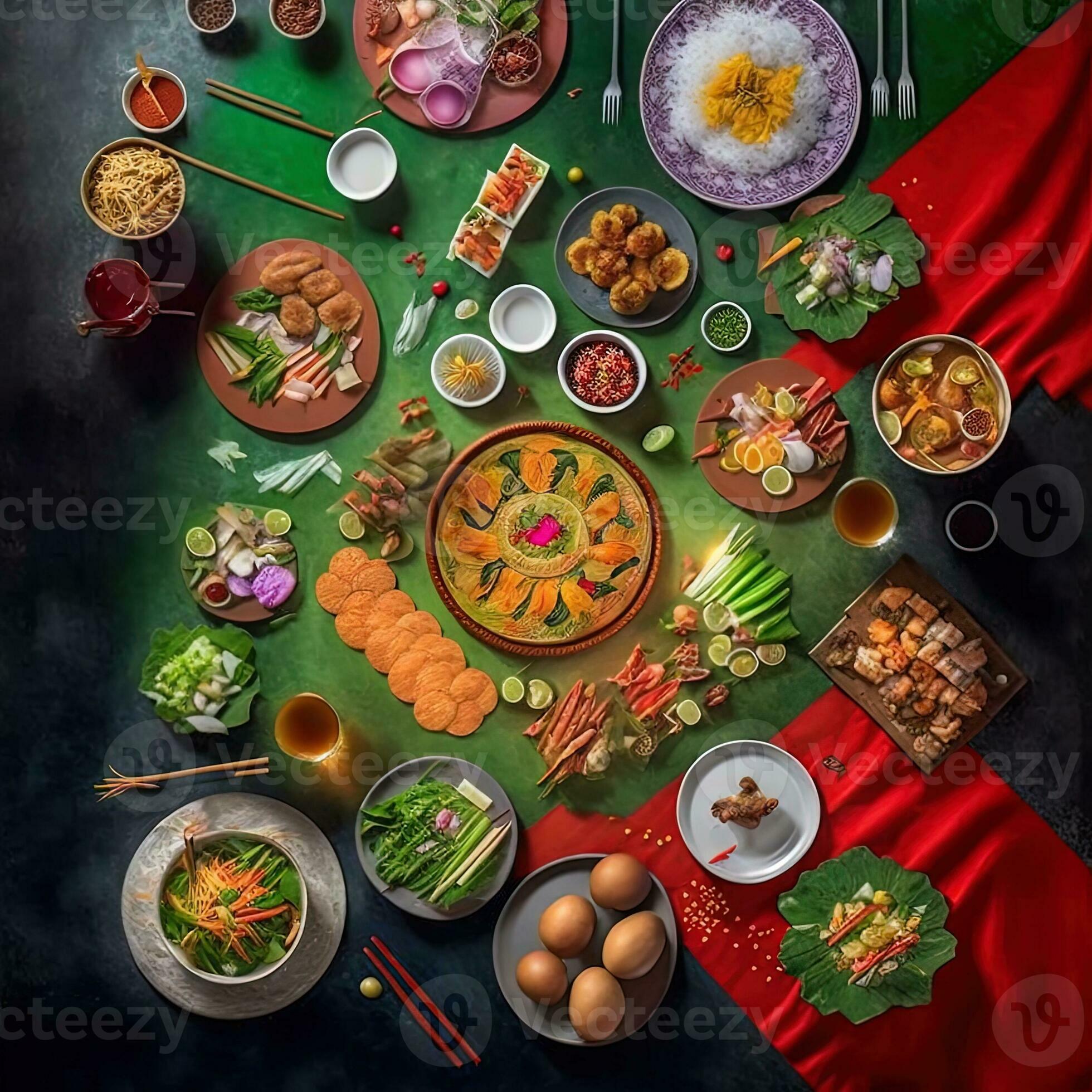
Bánh Chưng – Sticky Rice Cake
Bánh chưng holds deep cultural and historical significance for Vietnamese people. Legend traces its origins back to the Hùng Kings era, when a prince won the throne by making exceptionally delicious square cakes. Banh chuung remains a centerpiece of Tết celebrations today.
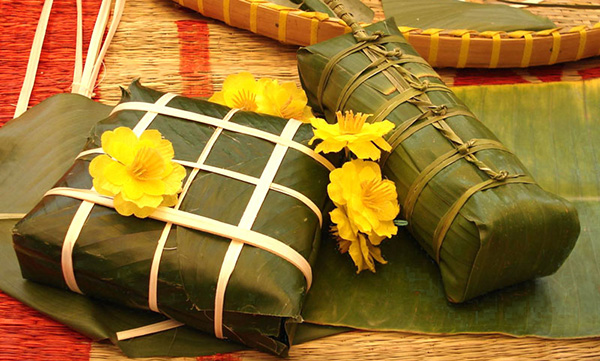
Making the labor intensive bánh chưng is a communal ritual often involving entire villages. Rice, mung beans, and pork get seasoned and layered then wrapped tightly in hardy dong leaves. The bulky green parcels get nestled into huge pots and slow-boiled for 8 to 12 hours, requiring constant monitoring. This tradition reaffirms social connections through shared work and passing on food preparation knowledge.
When done, the moist rice cakes are unwrapped and sliced to reveal the pillars of Vietnamese cuisine – rice, greens, pork, and beans. Bánh chưng is served at New Year’s ancestral worship ceremonies and gifted to family, neighbors, and friends. Leftovers make tasty snacks or can get fried into crispy bánh chưng chiên pancakes.
Giò Chả – Vietnamese Sausage
Giò chả is another quintessential Vietnamese New Year food. These sausages get their characteristic deep brownish red tint from anise seed, an auspicious ingredient thought to bring prosperity.
To make giò lụa, seasoned ground pork gets stuffed into bacon or banana leaf wrappers then slowly grilled. The irresistible slices of garlicky, aromatic sausage get dipped in vinegar and served as an appetizer for Tết feasts. They can also be used as a filling for bánh mì sandwiches.
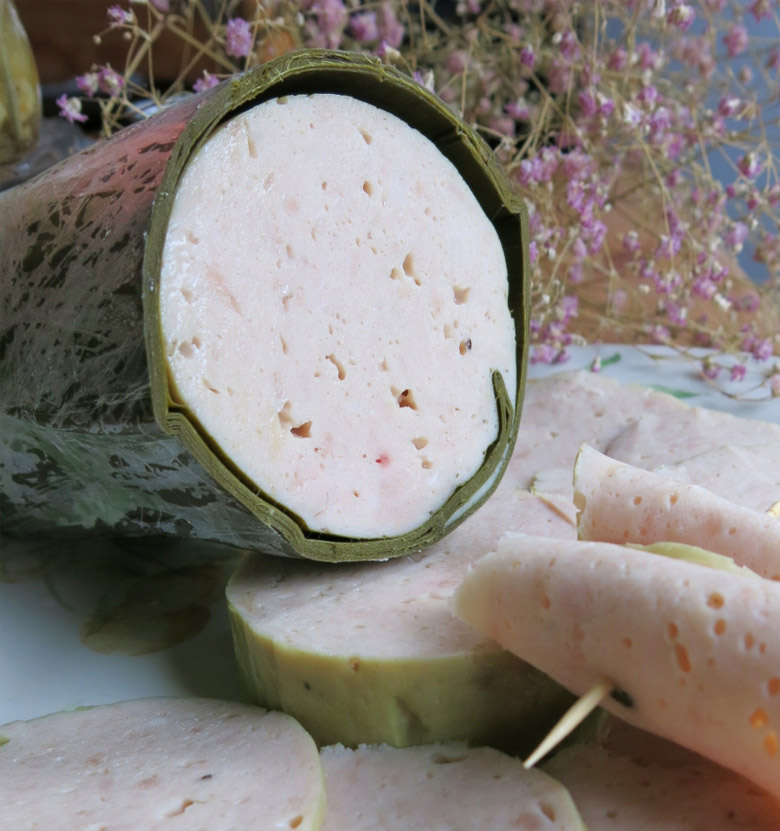
Giò chả references Ông Táo, the whimsical Kitchen God figure believed to ride a carp back to heaven just before Tết to report on the family’s happenings over the past year. The reddish-brown color echoes Ông Táo’s mythical firey kitchens. This connection gives giò chả special symbolic significance for Vietnamese New Year.
Bánh Tét – Cylindrical Sticky Rice Cake
Bánh tét are chewy cylindrical sticky rice cakes traditionally eaten for Tết. Tét means to construct or build in Vietnamese, referencing the labor involved in assembling the ingredients by hand. Banh tet starts with a core of mung bean and pork wrapped tightly in banana leaves then boiled for hours.
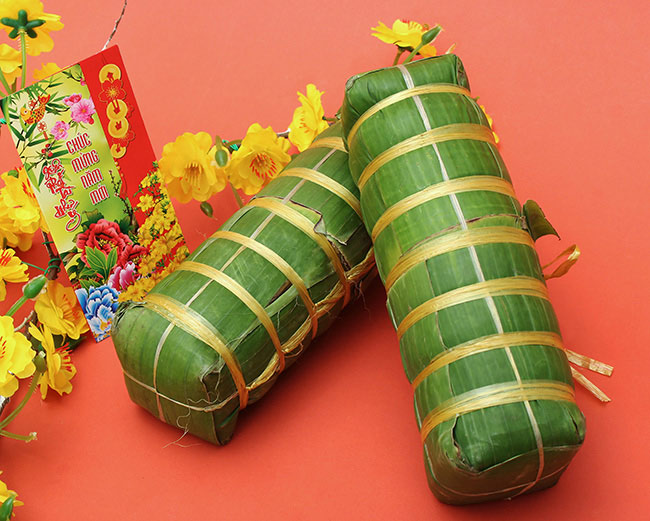
When sliced, the layers of contrasting white, green, and brown signify the balance of yin and yang energies. Bánh tét is served as a breakfast food or snack throughout the multi-day Vietnamese New Year celebrations. It keeps well at room temperature.
The cylindrical shape and green banana leaf wrapping represents Dong Son drums, a regal 3,000 year old instrument of Vietnam’s ancient imperial past. By enjoying bánh tét, people symbolically summon their illustrious history and culture. This imperial connection gives the humble bánh tét an auspicious grandeur perfect for celebrating Vietnamese New Year.
Common Questions about Vietnamese New Year Food
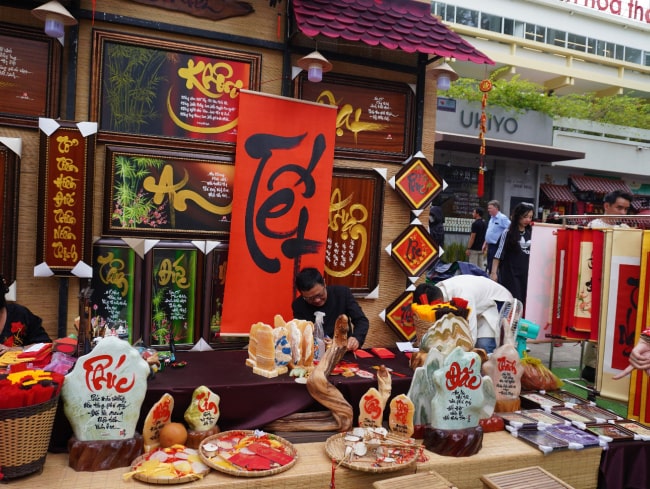
What are the most important Vietnamese New Year foods?
Some of the most essential Vietnamese New Year foods are bánh chưng (sticky rice cake), giò lụa/chả (sausage), whole steamed fish, bánh tét (rice cake), and candied fruits.
Why do Vietnamese eat a whole fish for New Year’s?
Serving a whole fish at New Year symbolizes prosperity, luck, and surplus for the coming year. Fish are highly respected in Vietnam for their symbolic links to abundance and fertility.
What types of fruits do Vietnamese eat for Tết?
Popular fruits eaten during Tết Nguyên Đán include pomelo, kumquats, coconut, green bananas, cinnamon apples, dragonfruit, rambutan, dưa hành (lime/pickles), sugarcane, and dried fruits.
What makes bánh chưng green?
Bánh chưng gets its iconic green color from being wrapped and boiled in dong or banana leaves. Dong leaf contains plant pigments that infuse the glutinous rice filling with green.
Why are bananas important for Vietnamese New Year?
Green bananas symbolize the arrival of spring and the bounty of fresh fruits to come. Banana leaves wrap food parcels like bánh tét and add fragrant flavor while cooking.
Conclusion
Food is deeply interwoven into the essence of Tết Nguyên Đán. The dishes served during Vietnamese New Year celebrations offer more than just physical nourishment – they provide symbolic spiritual and cultural nutrition. Preparing and enjoying auspicious foods like bánh chưng, bánh tét, and giò chả reaffirms family bonds and connects people to centuries of living heritage. The reverence and ritual surrounding Vietnamese New Year food traditions encapsulate the holiday’s beautiful layers of meaning and abundant joy.
